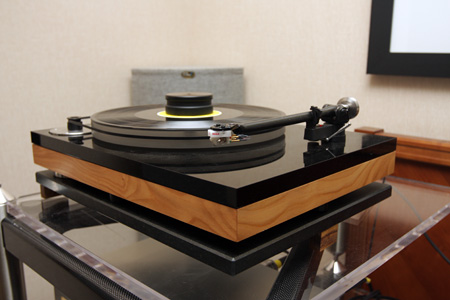|


|
Marc Mickelson Sunday, October 12
One final turntable, and another I'd like to
hear in my own system. Ayre Acoustics may be well known for its solid-state amps and
preamps, but I predict that the company's DPS turntable will begin to change this. The
DPS, "der Plattenspieler" in German, features a zero-clearance spindle bearing
that, contrary to conventional thought, provides resistance for the motor,
ensuring constant rotational speed. Disparate materials make for more effective isolation,
so the multilayer plinth of wood, foil and cork sits on three elastomer pucks, with a
granite base below that. The acrylic top plate supports the tonearm and main bearing. The
external three-phase power supply is a zero-feedback design -- one of Ayre's professed
design goals.

The DPS comes standard with a specially
modified Rega 250 tonearm, although it can also be ordered without the 'arm. Projected
prices are $9050 with the tonearm and $8250 without.
Saturday, October 11
Computer audio is commonplace at the RMAF.
When you see an audio system that includes a video screen, it's far more likely to be
displaying a listing of music titles than a movie or concert video. Yet, for a budding new
way to listen to music, computer audio is woefully underexplained. I have worked in IT and
have much more than a rudimentary understanding of computers, peripherals, and operating
systems, so perhaps I'm an especially tough audience to please. Still, the display of some
technical understanding in articles would be nice, if for no other reason than to back up
the notion that computer audio deserves all of the attention it is getting.
I'd like to see a cogent explanation of why
computer-based audio is better theoretically and sonically, not statements that
it simply is better. How about some research and consideration? I'm not saying
this doesn't exist, but I am saying that even modest bits of it are missing from most
articles I've read. How is reading digital music from a hard drive or from memory
different from reading it off a CD? Are there inherent advantages and disadvantages of USB
and FireWire connections? Is wireless streaming superior or inferior to a cabled
connection? Is a Mac or PC the superior music source? Why? What about the plentiful RFI
that computers emit? How does that affect sound?
There is an abundance of snap judgments --
"It's the best I've heard!" -- and a scarcity of useful, convincing explanation.
There is great expertise among the people who design and build the products covered, so
asking those people some questions would be a natural place to begin.
Friday, October 10
Fall is definitely in the Denver air,
turning a music lover's thoughts to the upcoming indoor listening season -- known to
others as winter. As I walked around the Fest, my eyes were drawn to turntables, including
two interesting new models I know I'd like to hear in my system this winter.

Dr. Christian Feickert is a well-known analog personality
because of his effective protractor for cartridge setup. Most recently he has introduced a
software suite that aids in precise cartridge alignment and a turntable, the Twin (above,
$8000 without tonearm), which is bursting with innovative features, including a motor
controller with a built-in world clock and the use of a Kevlar drive belt that should
never stretch or wear out. The Twin also feature something called MARC (mechanical
anti-resonant circuit), so it must be special.

Equally new and interesting is the Artemis
Labs SA-1 ($7800 without tonearm), whose plinth is a three-layer sandwich, with each
layer comprising three layers of bamboo -- so nine layers total. The platter is machined
from aircraft-grade aluminum, and the spindle doesn't contact the record. The 'table's
pulley system keeps the belt from slipping, and the belt is made from reel-to-reel tape,
so an owner can make new belts himself. Artemis is working on a second 'table that will
accommodate 12" tonearms.
|
|
|

